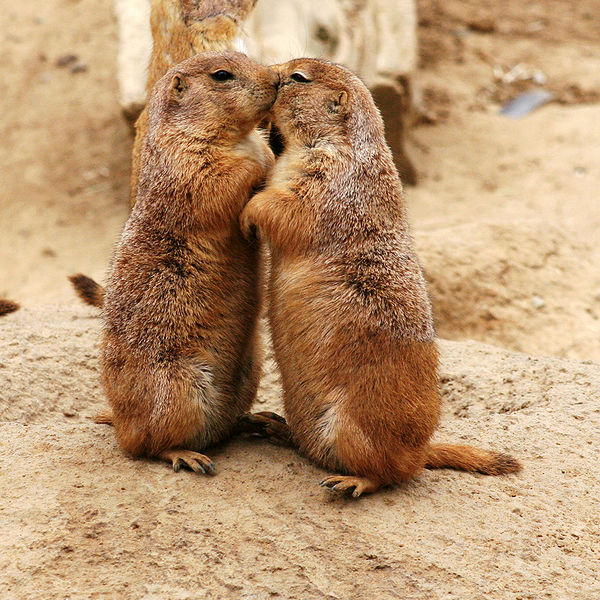It is summer, July already! Vacation time for kids and the people that love them.
Though many years past, I recall fondly one of our first family trips to the Black Hills of South Dakota. While en route, we stopped in the Badlands National Park. Though the Badlands might appear a barren, treeless desert (and believe me, in the western summer sun it feels that way), the area is loaded with animal life. Particularly intriguing to me were some small rodent residents, the prairie dogs.
Yes, prairie dogs are small and cute. Classified as rodents, these small mammals are most closely related to squirrels (1). But there was something particularly interesting about them. Rather than simply scurry around like a squirrel or gopher, the prairie dogs lived in villages of burrows. You might see a prairie dog sit upright, watching the surroundings, then suddenly chirp or bark, and with a flash of their short tail, dash into a burrow. One prairie dog’s chirp might send others running into burrows, or instead, elicit a response from another prairie dog.
Prairie dogs do in fact live in highly structured, social communities (1,2). If one prairie dog approaches another’s burrow, the dog positioned at the entrance will carefully sniff an inspection before allowing entry to the burrow. One doesn’t have to watch too long to notice embraces between dogs, or the playful wrestling of prairie dog pups.
Prairie dogs are found in the grasslands and prairies of North America (1). In the US this includes western South Dakota and the Four Corners area of southern Colorado, southwestern Utah, and northern Arizona and New Mexico. But their numbers are dwindling (1,2).
These small rodents are considered a bain to ranchers and landowners that blame them for destroying grassland and digging burrows that pose a risk to livestock. An acquaintance recently mentioned that he was driving to South Dakota to hunt prairie dogs, sad news to me, though a source of relief to ranchers that find nothing redeeming about these small critters that encroach on their private property. As noted in E-magazine.com, the online version of Environment, in the July/August 2004 edition (3):
“There are five species of prairie dog, and all of them are native to North America.Their situation can best be described as perilous, even with some present or pending protection under the Endangered Species Act (ESA). The status of white-tailed dogs is under federal review. Black-tailed dogs are candidates for listing. The Utah prairie dog is classified as “threatened,” and the Mexican as “endangered.” The Gunnison’s lacks all protection. “
The hunting of and dwindling numbers of prairie dogs is particularly troubling as information comes to light that prairie dogs not only live in structured social communities but have an established, and rather complex system of communication. Con Slobodchikoff, Ph.D. and his students at Northern Arizona University have studied and published reports on prairie dog vocalizations for 30 years. They have documented that prairie dog alarm calls differ depending on the predator (alarm calls differ for a badger and a coyote) and on the speed and direction of movement of the predator (2).
Furthermore, Slobodchikoff has shown that prairie dogs can distinguish humans by their clothing. In a 2009 report Slobodchikoff et al showed that prairie dog alarm calls differed depending on the shirt color worn by similarly-sized women while walking through a colony (4).
These intricate warning calls make sense considering the variety of predators prairie dogs face. A burrowing owl or hawk will have a different direction and speed of approach compared to a coyote. As well, a badger or coyote will approach a colony at different speeds and attack using different tactics. The ability to communicate this information to colony members improves each prairie dog’s chance of survival.
Included in this February 2010 BBC article is a video demonstrating how prairie dogs react differently to calls for coyotes and badgers.
Critics question whether one short bark could really relay information about size, color, direction and speed of attack, but Slobodchikoff believes that variations in the modulation and harmonics of the bark allow detailed information in the short calls (4).
Enjoy your vacation! And if you see any prairie dogs, let us know.
References
- Prairie dog Wikipedia page: http://en.wikipedia.org/wiki/Prairie_dog (accessed 13-July-2-10).
- Walker, M. (2 Feb. 2010) Burrowing US prairie dogs use complex language. BBC Earth News. http://news.bbc.co.uk/earth/hi/earth_news/newsid_8493000/8493089.stm (accessed July 13, 2010).
- Durso, F. Jr., Motavalli, J. (2004) Open Season on ‘Varmints’: For Saving Endangered Prairie Dogs, It’s the Eleventh Hour. E-The Environmental Magazine online version: https://emagazine.com/open-season-on-varmints/ (accessed 13-Jul-2010).
- Slobodchikoff, CN, Paseka, A, Verdolin, JL (2009) Prairie dog alarm calls encode labels about predator color. Animal Cognition 12, 435-9. PMID: 19116730.

